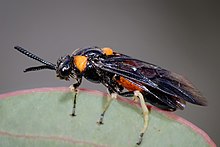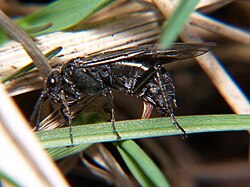A sawfly is an insect belonging to suborder Symphyta of the order Hymenoptera. The sawflies are a group of largely plant-eating (herbivorous) insects. The group is less specialised than the ants, bees and wasps.
| Sawfly Temporal range: Triassic – Recent
| |
|---|---|

| |
| Melaleuca | |
| Scientific classification | |
| Kingdom: | |
| Phylum: | |
| Class: | |
| Order: | |
| Suborder: | Symphyta
|

Sawflies differ from most other Hymenoptera by their broad connection between the abdomen and the thorax, and by their caterpillar-like larvae. The common name comes from the saw-like appearance of the ovipositor, which the females use to cut into the plants where they lay their eggs. Large populations of certain sawfly species may cause economic damage to forests and cultivated plants.
As of 2013, the Symphyta are treated as nine superfamilies (one extinct) and 25 families. Most sawflies belong to the Tenthredinoidea superfamily, with about 7,000 species worldwide. Tenthredinoidea has six families, of which Tenthredinidae is by far the largest with some 5,500 species.[1]
Xyelidae
changeThe Xyelidae is a small family of sawflies known from fewer than 50 living species in five genera, with an extensive fossil record. They are the oldest fossil Hymenoptera, dating back to the Triassic, some 200 million years ago.
Most species occur in the Northern hemisphere, especially in boreal regions, though there are a few neotropical species. Most are associated with conifers (esp. Pinus and Abies), where the larvae feed on pollen or within buds, though larvae of a few species feed on the leaves of deciduous trees.
References
change- ↑ Aguiar A.P.; et al. (2013). "Order Hymenoptera In: Zhang Z.-Q. (ed) Animal biodiversity: an outline of higher-level classification and survey of taxonomic richness". Zootaxa. 3703 (1): 51–62. doi:10.11646/zootaxa.3703.1.12. Archived from the original on 2016-12-31. Retrieved 2019-02-04.